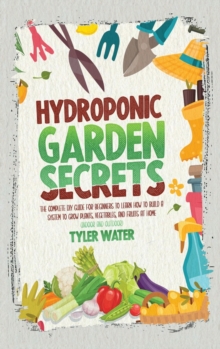** COLOR EDITION **
Do you want to discover a scientific technique for building your own hydroponic garden? Then keep reading...
Hydroponics is a means of growing plants without soil. It makes use of nutrient-rich water or a nutrient solution as well as techniques that allow the plant to grow. You can also use sand or gravel, with added nutrients. In this chapter, you are going to learn the history of the growing art that we call hydroponics. You will also learn about some of its practical uses throughout history.
Traditionally, the soil is used to grow plants. It was thought that soil was necessary since plants started out in the earth, with nutrient-rich soils like the strawberry plants that were first grown in the wild before being cultivated for gardens. At some point in history, it was discovered that the soil was not necessary for the growing process. Rather, the role of soil is to act as a reservoir to hold the nutrients that a plant needs in order to grow.
Crops grown hydroponically, according to studies, grow faster and healthier and are better than crops grown on soil; this is because they would not have to go through a lot of disadvantages that the soil may present, such as; situations of a break out of a soil-borne disease in the area, the struggle to have to push its way through the soil during germination, the attack from organism and pests that live in the soil. And of course, the plants in hydroponic systems do not have to 'hustle' for nutrients and water because this is basically what they are planted in, in hydroponic systems-water-based mineral nutrient solutions.
Hydroponics also helps you save water, which sounds a bit strange when you think of water is essential for this process. Usually, it's every alternate day so that the soil soaks up the water and is transported to the roots. That sounds fine, doesn't it? But that's only a portion of the big picture. Some of the water is bound to seep out of the container, some of it evaporates, and a portion of it seeps further into the soil beyond the plant's roots. So, in practice, the plant essentially only uses up a small portion of the water. Hydroponics uses a simple recirculating mechanism that ensures that the water is fully soaked up by the roots. It means that the portion of water that isn't absorbed by the plant is directly sent to the reservoir. The same water from the reservoir is later pumped up to the plants. Since the reservoir is shut tight, there is no chance for the water to evaporate, and it certainly will not seep out of the bottom of the container. You can save around 80% of the water by switching to hydroponics instead of using regular soil gardening.
This book covers the following topics:
- Equipment
- Hydroponic Growing System
- Plant necessities
- Best plant for hydroponics
- Pest and disease
- Choosing the right site for your garden
- Maintenance of your hydroponic garden
And Much More!
Do not get scared; hydroponic gardening is not as complicated, tricky, and demanding as your mind is about to convince you that it is; on the contrary, it is very simple! And this is what this book is about-to enlighten you and get you started on having your own hydroponic garden.
Ready to get started? Click "Buy Now"!

